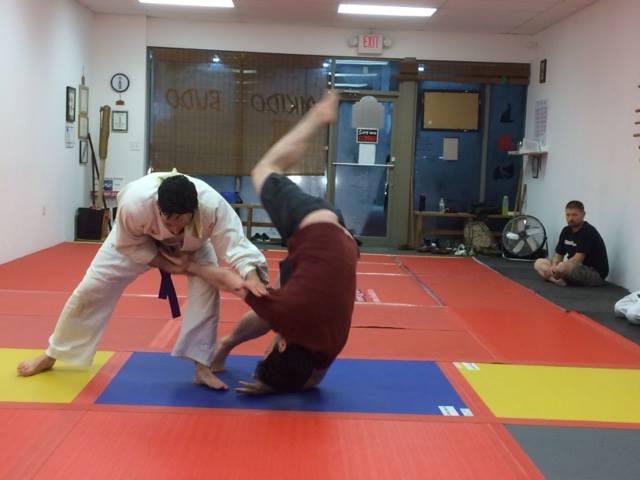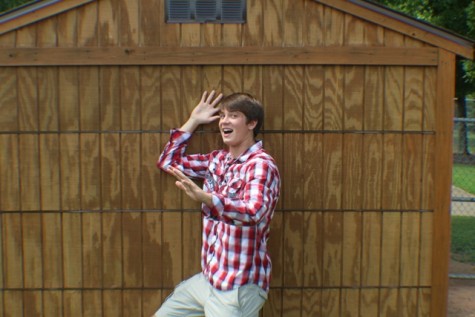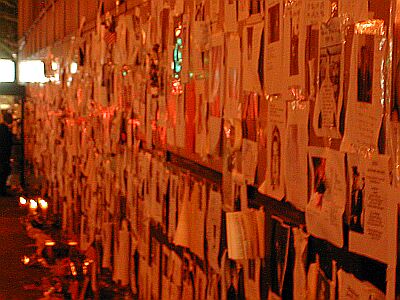The Spirit Behind Japanese Martial Arts
An aikido practitioner throws his counterpart during his test to rise in “belts”. Aikido, like Karate, is one of the martial arts to have emerged from the older fighting schools of Japan. (Used with permission from the Butoku of North Georgia Facebook page)
March 8, 2016
A flow of tradition has opened wide across the ocean between Japan and America. Since the
time of the Shogunate’s fall in World War II, their foods, their stories, their art, countless things
have melted into our culture from our island brothers. Beyond the many superficial ideas,
however, and even important cultural aspects, lies that which has been overshadowed and
plasticized in modern day times: the Japanese martial arts, or Budo, in their language. Society
finds such things difficult to take seriously, for example, as people bearing its title break their
hand upon a wooden plank. Budo has become little more than a petty sport, a feeble threat
thrown when cornered, and a laughingstock. Before they were warped into this, however, the
Japanese martial arts carried a far deeper importance.
From the very beginning of the East, with the great dynasties of China constantly looming, Japan
has been a center of strife and ever conflicting leadership. Even in ancient days before their
society gained any structure, they already faced warfare as the Chinese ever sought to invade and
conquer. From this beginning, they learned to defend against overwhelming odds and created
quite a golden empire despite such strife. Even so, they were not able to keep from descending
into chaos, and by the late Dark Ages, Japanese society was run by warlords and battling states.
Here lies the birth of our Martial sports. A society in constant battle must learn to become
greater than any rival. As Europe found this in their weapons and technology, Japan found it in
the skill of combat. Masters of fighting emerged from those that survived among the battles of
their states, each having realized a skill that could give them the upper hand. Some found it in
unmatched sword work, such as the esteemed Miyamoto Musashi. Others found it in hand to
hand combat, creating schools that would inspire the modern day art of Karate and other known
styles. Others discovered far more efficient ways of bow mastery, or battling with melee
weaponry, and in far later times, firearms. These fighting styles meant far more than simply
another tradition to be practiced; they were the means of survival, passed down from generation
and warband. They taught the body how to move more effectively in any realm of life, and how
the body’s movements are nothing but reflections of any movement, physical or otherwise.
The Japanese culture grew great on this almost philosophical understanding of war, allowing it to
morph and adapt through time. It was upon this that they were able to face the outreaching
world and conquer as ever through the 1800’s. However, no amount of skill could save the
Japanese culture from the massive blow of an Atomic Bomb, and the consequences that would
follow for their actions in WWII. In the treaty following, they were forbidden to practice any
form of war, including the martial arts they had prided themselves on.
Well, one cannot simply give up the traditions that their ancestors prided themselves upon, and
the Japanese were certainly not going to throw away countless generations of work. As all great
cultures do when faced with such a challenge, they improvised. Many masters of the martial arts
learned to conceal their teachings and practice in secret, while a majority turned to an unlikely
opportunity: turning their arts into sport. The many schools of fighting coalesced into “innocent”
sport leagues in order to preserve their culture: swordsmanship schools formed the Japanese
fencing art, Kendo; certain forms of hand to hand combat combined into Karate and Aikido and
such. Though reduced to a mere game, the Japanese martial arts were able to survive long past
their intended demise.
Remember that not all sports were created as a source of mere entertainment. Some, such as the
martial arts from Japan, helped carry on a nearly lost history, and all the honor it carried for such
a nation.













